Gibilisco S. Teach Yourself Electricity and Electronics
Подождите немного. Документ загружается.

ANTENNAS CAN BE CATEGORIZED INTO TWO MAJOR CLASSES: RECEIVING TYPES AND TRANSMITTING
types. Most transmitting antennas can also function effectively for reception. Some receiving anten-
nas can efficiently transmit EM signals; others cannot.
Radiation Resistance
When RF current flows in an electrical conductor, some EM energy is radiated into space. If a resis-
tor is substituted for the antenna, in combination with a capacitor or inductor to mimic any inher-
ent reactance in the antenna, the transmitter behaves in the same manner as when connected to the
actual antenna. For any antenna operating at a specific frequency, there exists a specific resistance,
in ohms, for which this can be done. This is known as the radiation resistance (R
R
) of the antenna at
the frequency in question. Radiation resistance is specified in ohms. This phenomenon was intro-
duced in Chap. 17. Now you’ll see why it’s important!
Determining Factors
Suppose a thin, straight, lossless vertical antenna is placed over perfectly conducting ground. Then
R
R
is a function of the vertical-antenna conductor height in wavelengths (Fig. 27-1A). Suppose a
thin, straight, lossless wire is placed in free space and fed at the center. Then R
R
is a function of the
overall conductor length in wavelengths (Fig. 27-1B).
Antenna Efficiency
Efficiency is rarely crucial to the performance of a receiving antenna system, but it is important in
any transmitting antenna system. Radiation resistance always appears in series with loss resistance
(R
L
). The antenna efficiency, Eff, is given by:
Eff = R
R
/(R
R
+ R
L
)
471
27
CHAPTER
Antennas
Copyright © 2006, 2002, 1997, 1993 by The McGraw-Hill Companies, Inc. Click here for terms of use.
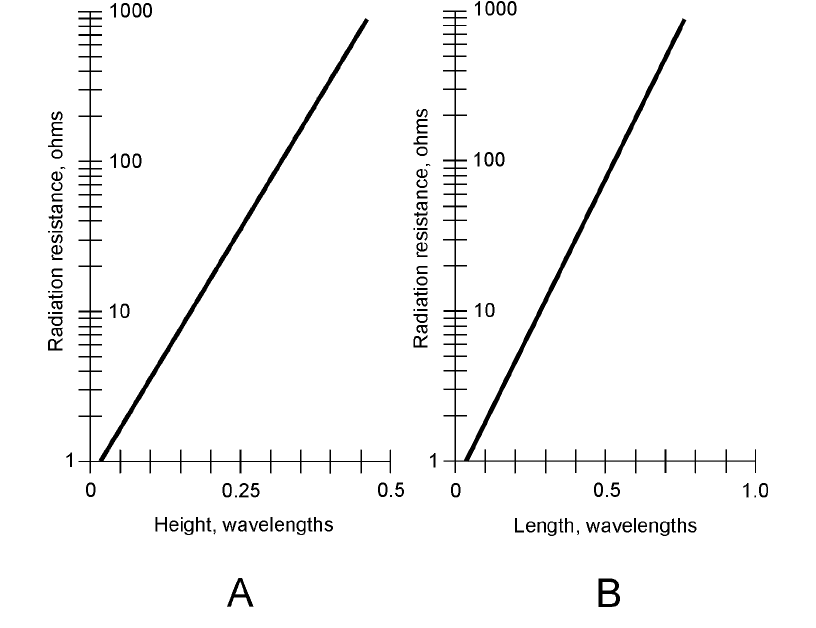
which is the ratio of the radiation resistance to the total antenna system resistance. As a percentage,
Eff
%
= 100 R
R
/(R
R
+ R
L
)
High efficiency in a transmitting antenna is obtained when the radiation resistance is much
larger than the loss resistance. Then most of the power goes into useful EM radiation, and relatively
little is dissipated as heat in the earth and in objects surrounding the antenna. When the opposite
situation exists—radiation resistance comparable to, or smaller than, the loss resistance, a transmit-
ting antenna is inefficient. This is often the case for extremely short radiators, because they always
have low radiation resistance. To some extent this can be overcome by careful antenna design and
location to minimize loss resistance, but even the most concerted efforts rarely reduce the loss resist-
ance to less than a few ohms.
If an antenna system has a high loss resistance, it can nevertheless work efficiently if its radia-
tion resistance is high enough. When an antenna radiator is just the right length at a given fre-
quency, and if it is constructed of wire or thin tubing, its radiation resistance can be in excess of
1000 Ω. This makes it easy to construct an efficient antenna even when the loss resistance is fairly
high.
472 Antennas
27-1 Approximate values of radiation resistance for vertical antennas over perfectly
conducting ground (A) and for center-fed antennas in free space (B).
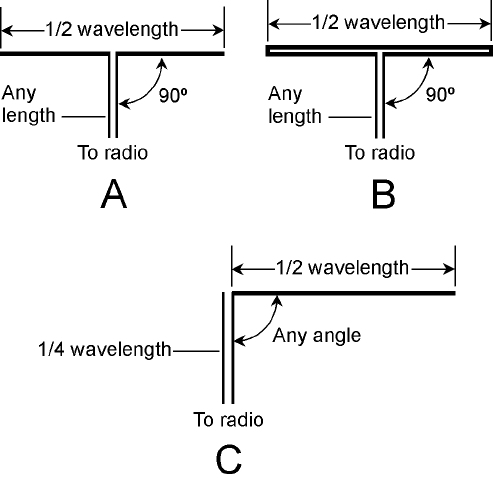
Half-Wave Antennas
A half wavelength in free space is given by the equation:
L
ft
= 492/f
o
where L
ft
is the linear distance in feet, and f
o
is the fundamental frequency, in megahertz, at which
the antenna exhibits resonance. A half wavelength in meters, L
m
, is given by:
L
m
= 150/f
o
For ordinary wire, the results as obtained above should be multiplied by a velocity factor, v, of 0.95
(95 percent). For tubing or large-diameter wire, v can range down to about 0.90 (90 percent).
Open Dipole
An open dipole or doublet is a half-wavelength (λ/2) radiator fed at the center (Fig. 27-2A). Each leg
of the antenna is a quarter wavelength (λ/4) long. For a straight wire radiator, the length L
ft
, in feet,
at a design frequency f
o
, in megahertz, for a center-fed, λ/2 dipole is approximately:
L
ft
= 468/f
o
The length in meters is approximately:
L
m
= 143/f
o
Half-Wave Antennas 473
27-2 Basic half-wave
antennas. At A, dipole
antenna. At B, folded-
dipole antenna. At C,
zepp antenna.
These values assume v = 0.95. In free space, the impedance at the feed point is a pure resistance of
approximately 73 Ω. This represents the radiation resistance alone, in the absence of reactance at the
resonant frequency.
Folded Dipole
A folded dipole antenna is a λ/2, center-fed antenna constructed of two parallel wires with their ends
connected together (Fig. 27-2B). The feed-point impedance of the folded dipole is a pure resistance
of approximately 290 Ω. This makes the folded dipole ideal for use with high-impedance, parallel-
wire transmission lines in applications where gain and directivity are not especially important.
Half-Wave Vertical
A radiator measuring λ/2 can be stood up, fed at the base (the bottom end) against an earth ground
with a transmatch or antenna tuner designed for high impedances, and connected to a radio by a
coaxial cable feed line. This type of antenna is an efficient radiator even in the presence of consider-
able loss resistance, because the radiation resistance is extremely high.
Zepp
A zeppelin antenna, also called a zepp, is a λ/2 radiator, fed at one end with a λ/4 section of open-
wire line (Fig. 27-2C). The impedance at the feed point is an extremely high, pure resistance. At the
transmitter end of the line, the impedance is a low, pure resistance. A zeppelin antenna can operate
well at all harmonics of the design frequency. If an antenna tuner, also called a transmatch, is avail-
able to tune out reactance, the feed line can be of any length. Feed-line radiation can be minimized
by carefully cutting the radiator to λ/2 at the fundamental frequency, and by using the antenna only
at this frequency or one of its harmonics. Zepp antennas are rarely used at frequencies above 30
MHz, except when modified to form a J pole.
J Pole
A zepp can be oriented vertically, and the feed line placed so it lies in the same line as the radiating
element. This antenna, called a J pole, radiates equally well in all horizontal directions. The J pole is
used as a low-budget antenna at frequencies from approximately 10 MHz up through 300 MHz. It
is, in effect, a λ/2 vertical fed with an impedance matching section consisting of a length of transmis-
sion line measuring λ/4. It does not require any radials, and this makes it convenient in locations
where space is at a premium.
Some radio amateurs hang long J poles, cut for 3.5 MHz or 1.8 MHz, from kites or helium-
filled balloons. Such antennas work well, but they are dangerous if they are not properly tethered to
prevent them from breaking off and flying away, or if they are placed where they might fall on power
lines. They can develop considerable electrostatic charge, even in clear weather. They are deadly if
flown in or near thunderstorms.
Quarter-Wave Verticals
A quarter wavelength is related to frequency by the equation:
L
ft
= 246v/f
o
474 Antennas

where L
ft
represents λ/4 in feet, f
o
represents the frequency in megahertz, and v represents the veloc-
ity factor. If the length is expressed in meters as L
m
, then the formula is:
L
m
= 75v/f
o
For a typical wire conductor, v = 0.95 (95 percent); for metal tubing, v can range down to approx-
imately 0.90 (90 percent).
A λ/4 antenna must be operated against a low-loss RF ground. The feed-point impedance over
perfectly conducting ground is approximately 37 Ω. This represents radiation resistance in the ab-
sence of reactance, and provides a reasonable impedance match to most coaxial transmission lines.
Ground-Mounted Vertical
The simplest vertical antenna is a λ/4 radiator mounted at ground level. The radiator is fed with a
coaxial cable. The center conductor is connected to the base of the radiator, and the shield is con-
nected to a ground system.
Unless an extensive ground radial system is installed, a ground-mounted vertical is likely to be
inefficient unless the surface happens to be an excellent conductor (saltwater or a salt marsh, for ex-
ample). Another problem is the fact that vertically polarized antennas receive more human-made
noise than horizontal antennas. In addition, the EM fields from ground-mounted transmitting an-
tennas are more likely to cause interference to nearby electronic devices than are the EM fields from
antennas installed at a height.
Ground Plane
A ground-plane antenna is a vertical radiator, usually measuring λ/4, operated against a system of λ/4
conductors called radials. The feed point, where the feed line joins the antenna radiator and the hub
of the radial system, is elevated. When the feed point is at least λ/4 above the ground, only three or
four radials are necessary to obtain a low-loss RF ground system. The radials extend outward from
the base of the antenna at an angle between 0° and 45° with respect to the horizon. Figure 27-3A
illustrates a typical ground-plane antenna with four horizontal radials.
A ground-plane antenna should be fed with coaxial cable. The feed-point impedance of a
ground-plane antenna having a λ/2 radiator is about 37 Ω if the radials are horizontal; the imped-
ance increases as the radials droop, reaching about 50 Ω at a droop angle of 45°.
Quarter-Wave Verticals 475
27-3 Basic quarter-wave
verticals. At A,
ground-plane antenna.
At B, coaxial antenna.
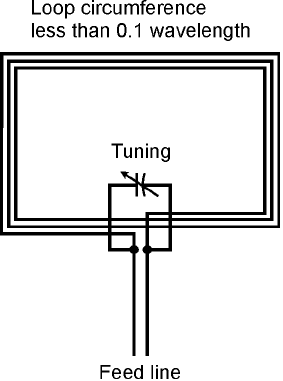
Coaxial Antenna
The radials in a ground-plane antenna can extend straight downward, and then can be merged to
form a λ/2 cylinder or sleeve that is concentric with the feed line. In this case, the feed-point imped-
ance is approximately 73 Ω. This is known as a coaxial antenna (Fig. 27-3B).
Loops
Any receiving or transmitting antenna, consisting of one or more turns of wire forming a dc short
circuit, comprises a loop antenna.
Small Loop
A small loop antenna has a circumference of less than 0.1λ (for each turn) and is suitable for receiv-
ing, but generally not for transmitting. It is the least responsive to signals coming from along its axis,
and most responsive in the plane perpendicular to its axis. A capacitor can be connected in series or
parallel with the loop to provide a resonant response. An example of such an arrangement is shown
in Fig. 27-4.
Small loops are useful for radio direction finding (RDF), and also for reducing interference
caused by human-made noise or strong local signals. The null along the axis is sharp and deep, and
can be pointed in the direction of an offending signal or noise source.
Loopstick
For receiving applications at frequencies up to approximately 20 MHz, a loopstick antenna is some-
times used. This antenna, a variant of the small loop, consists of a coil wound on a solenoidal (rod-
shaped), powdered-iron core. A series or parallel capacitor, in conjunction with the coil, forms a
tuned circuit. A loopstick displays directional characteristics similar to those of the small loop an-
tenna shown in Fig. 27-4. The sensitivity is maximum off the sides of the coil, and a sharp null oc-
curs off the ends.
476 Antennas
27-4 A small loop antenna
with a capacitor for
adjusting the resonant
frequency.
Large Loop
A large loop antenna usually has a circumference of either λ/2 or λ (a full wavelength), is circular or
square in shape, and lies entirely in a single plane. It can work well for transmitting or receiving. The
λ/2 loop presents a high impedance at the feed point, and maximum radiation/response occurs in
the plane of the loop. The λ loop presents an impedance of about 100 Ω at the feed point, and the
maximum radiation/response occurs along the axis (that is, perpendicular to the plane containing
the loop).
The λ/2 loop exhibits a slight power loss relative to a λ/2 dipole in its favored directions. The
λ loop shows a slight gain over a λ/2 dipole in its favored directions. These properties hold for loops
up to several percent larger or smaller than exact λ/2 or λ circumferences (as determined for the
wavelength in free space). Resonance can be obtained by means of an antenna tuner if the loop is
fed with open-wire transmission line.
Sometimes, loop antennas measuring several wavelengths in circumference are strung up hori-
zontally among multiple supports. These are technically large loops, but their gain and directional
characteristics are hard to predict. If fed with open-wire line and an antenna tuner, and if placed at
least λ/4 above the surface, such an antenna can be exceptionally effective.
Ground Systems
End-fed λ/4 antennas, such as the ground plane, require low-loss RF ground systems in order to
perform efficiently. Center-fed λ/2 antennas, such as the dipole, do not. However, good grounding
is advisable for any antenna system in order to minimize interference and electrical hazards.
Electrical versus RF Ground
Electrical grounding is important for personal safety. It can help protect equipment from damage if
lightning strikes in the vicinity. It also minimizes the risk of electromagnetic interference (EMI) to and
from radio equipment. In a three-wire electrical system, the ground prong on the plug should never
be defeated, because such modification can result in dangerous voltages appearing on exposed metal
surfaces.
A good RF ground system can help minimize EMI, even if it is not necessary for efficient an-
tenna operation. Figure 27-5 shows a proper RF ground scheme (A) and an improper one (B). In a
good RF ground system, each device is connected to a common ground bus, which in turn runs to
the earth ground through a single conductor. This conductor should be as short as possible. A poor
ground system contains ground loops that can act like loop antennas and increase the risk of EMI.
Radials and the Counterpoise
With a surface-mounted vertical antenna, there should be as many radials as possible, and they
should be as long as possible. They can lie on the surface or be buried a few inches underground.
The greater the number of radials of a given length, the better the antenna will work. Also, the
longer the radials for a given number, the better. The radials should all converge toward, and be con-
nected to, a ground rod at the feed point.
A counterpoise is a means of obtaining an RF ground or ground plane without a direct earth-
ground connection. A grid of wires, a screen, or a metal sheet is placed above the surface and ori-
ented horizontally, to provide capacitive coupling to the earth. This minimizes RF ground loss.
Ideally, the radius of a counterpoise should be at least λ/4 at the lowest operating frequency.
Ground Systems 477
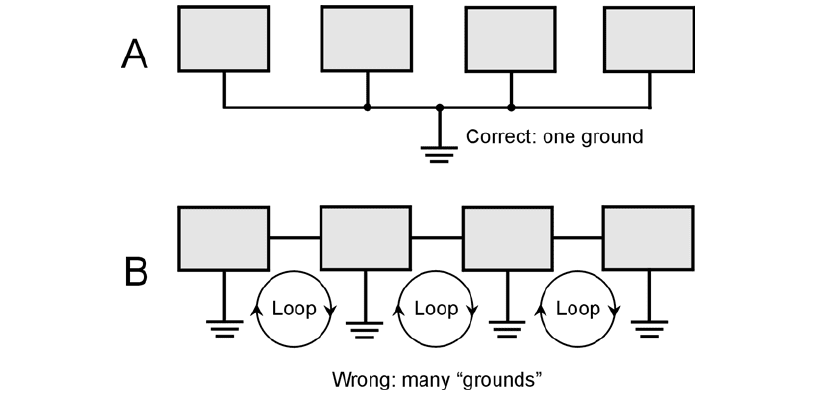
Gain and Directivity
The power gain of a transmitting antenna is the ratio of the maximum effective radiated power (ERP)
to the actual RF power applied at the feed point. Power gain is expressed in decibels (dB).
Suppose the ERP, in watts, for a given antenna is P
ERP
, and the applied power, also in watts, is
P. Then the following equation holds:
Power gain (dB) = 10 log
10
(P
ERP
/P)
Power gain is always measured in the favored direction or directions of an antenna. These are the di-
rections in which the antenna performs the best.
For power gain to be defined, a reference antenna must be chosen with a gain that is defined as
0 dB. This reference antenna is usually a λ/2 dipole in free space. Power-gain figures taken with re-
spect to a dipole (in its favored directions) are expressed in units called dBd. The reference antenna
for power-gain measurements can also be an isotropic antenna, which theoretically radiates and re-
ceives equally well in all directions in three dimensions. In this case, units of power gain are called
dBi. For any given antenna, the power gains in dBd and dBi are different by approximately 2.15 dB:
Power gain (dBi) = 2.15 + Power gain (dBd)
Directivity Plots
Antenna radiation and response patterns are represented by plots such as those shown in Fig. 27-6.
The location of the antenna is assumed to be at the center (or origin) of a polar coordinate system. The
478 Antennas
27-5 At A, the correct method for grounding multiple units. At B, an
incorrect method creates RF ground loops.
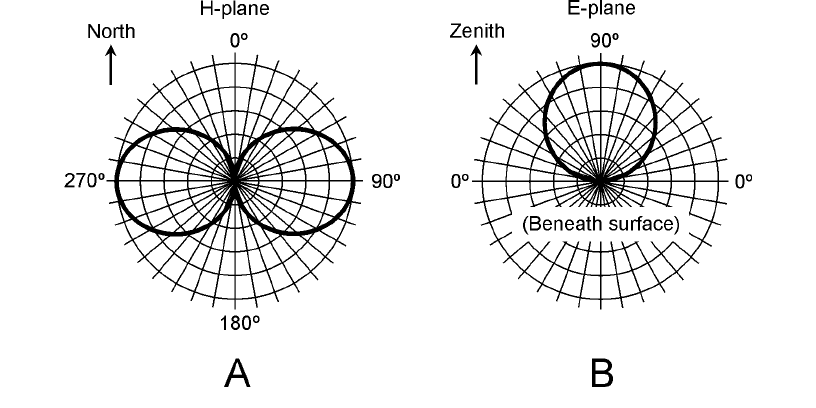
greater the radiation or reception capability of the antenna in a certain direction, the farther from
the center the points on the chart are plotted.
A dipole antenna, oriented horizontally so that its conductor runs in a north-south direction,
has a horizontal plane (or H plane) pattern similar to that in Fig. 27-6A. The elevation plane (or E
plane) pattern depends on the height of the antenna above effective ground at the viewing angle.
With the dipole oriented so that its conductor runs perpendicular to the page, and the antenna
1
⁄4
wavelength above effective ground, the E plane antenna pattern for a half-wave dipole resembles the
graph shown at B.
Forward Gain
Forward gain is expressed in terms of the ERP in the main lobe (favored direction) of a unidirectional
(one-directional) antenna compared with the ERP from a reference antenna, usually a half-wave di-
pole, in its favored directions. This gain is calculated and defined in dBd at microwave frequencies;
large dish antennas can have forward gain upward of 35 dBd. In general, as the wavelength decreases
(the frequency gets higher), it becomes easier to obtain high forward gain figures.
Front-to-Back Ratio
The front-to-back (f/b) ratio of a unidirectional antenna is an expression of the concentration of
radiation/response in the main lobe, relative to the direction opposite the center of the main lobe.
Figure 27-7 shows a hypothetical directivity plot for a unidirectional antenna pointed north. The
outer circle depicts the RF field strength in the direction of the center of the main lobe, and repre-
sents 0 dB. The next smaller circle represents a field strength 5 dB down with respect to the main
lobe. Continuing inward, circles represent 10 dB down, 15 dB down, and 20 dB down. The origin
represents 25 dB down, and also shows the location of the antenna. The f/b ratio is found, in this
case, by comparing the signal levels between north (azimuth 0°) and south (azimuth 180°).
Gain and Directivity 479
27-6 Directivity plots for a dipole antenna. At A, the H plane (horizontal plane) plot;
at B, the E plane (elevation plane) plot.
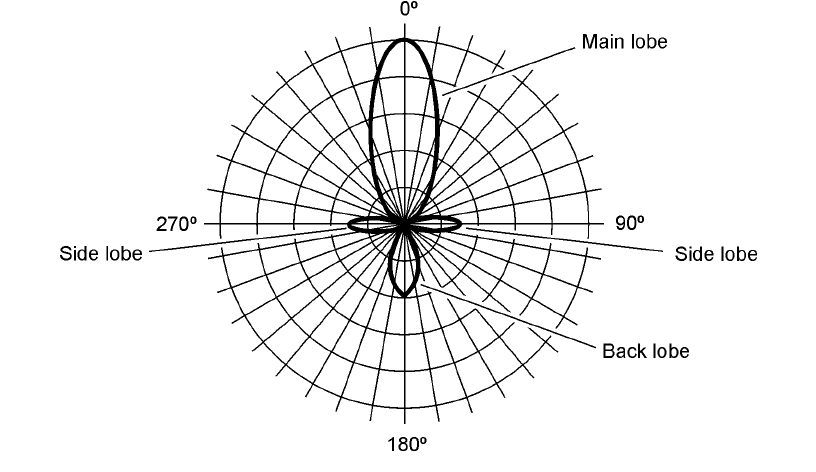
Front-to-Side Ratio
The front-to-side (f/s) ratio is another expression of the directivity of an antenna system. The term
applies to unidirectional antennas, and also to bidirectional antennas. The f/s ratio is expressed in
decibels (dBd), just as is the f/b ratio. The EM field strength in the favored direction is compared
with the field strength at right angles to the favored direction. An example is shown in Fig. 27-7.
The f/s ratios are found, in this case, by comparing the signal levels between north and east (right-
hand f/s), or between north and west (left-hand f/s). The right-hand and left-hand f/s ratios are usu-
ally the same in theory, although they can differ slightly in practice.
Phased Arrays
A phased array uses two or more driven elements (radiators connected directly to the feed line) to pro-
duce gain in some directions at the expense of other directions.
End-Fire Array
A typical end-fire array consists of two parallel λ/2 dipoles fed 90° out of phase and spaced λ/4
apart (Fig. 27-8A). This produces a unidirectional radiation pattern. Or, the two elements can be
driven in phase and spaced at a separation of λ (Fig. 27-8B). This results in a bidirectional radi-
ation pattern. In the phasing system, the branches of the transmission line must be cut to pre-
cisely the correct lengths, and the velocity factor of the line must be known and be taken into
account.
480 Antennas
27-7 Directivity plot for a hypothetical antenna. Front-to-back and front-to-side ratios
can be determined from such a graph. This plot is in the H plane.
